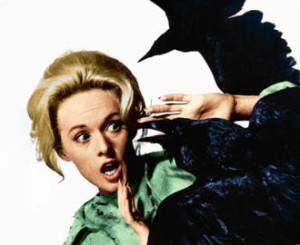More and more, cities across the US are being discovered by crows as the perfect place for a slumber party. Crows love to roost in cities on winter nights. And the crows congregate in vast numbers–some roosts are made up of hundreds of thousands of birds.
They’re impossible to ignore. When twenty thousand birds are swooping over your house, it can make you a little…well…nervous. Every time I see dark clouds of crows swirling overhead I’m reminded–who could not be?–of the movie. The movie. You know the one I mean, right? Admit it, the thought crosses your mind every time you see a flock of crows.
The Birds.
And the screaming feathered mob circling over the city night after night certainly does seem to be cause for alarm. Any moment now, it seems, the crows will swoop down and start pecking out eyeballs. Seems as though it could be…well, dangerous, to have thousands of crows roosting in such close proximity to humans.
You know how many humans have been killed in crow attacks?
None. None ever ever ever.
 Thanks to photographer Diane Hale Smith for this magnificent crow photograph.
Thanks to photographer Diane Hale Smith for this magnificent crow photograph.
The movie is fiction. Science fiction, not science. It’s based on a short story by Daphne du Maurier, the brilliant British author who also wrote Rebecca. (Incidentally she hated the movie, which is set in sunny California and stars a sexy blonde socialite. Her story was set in rainy Cornwall and featured a hard-working farmer as the main character.)
Like most people, I first saw this movie as a kid, staying up way past my bedtime, and was so traumatized that I wouldn’t feed the parakeet for a week. It’s a really effective movie. Hitchcock knew just how to scare the pants off people.
The movie was made in the sixties, long before the Humane Society was on hand during filming to make sure no harm came to any animals. Tippi Hedren, the lead actress, endured days of prop men throwing live crows, ravens and gulls at her, their beaks taped shut. When you watch that scene, remember that the most terrified ones in it are the poor birds. Tippi was bruised and bloodied, and had nightmares afterwards, but at least she survived. Not so sure about her avian co-stars.
One reason they used crows in the movie for so many scenes was not only that crows are big and scary. They’re also smart. Michael Westerfield, a scientist who has studied crows for years, says “There is increasing scientific evidence that the crows are highly intelligent animals, possessing a complex language and culture, capable of making and using tools, and possessing sophisticated problem solving abilities.”
Hm. Maybe someday they will get fed up with us and start organizing attacks on humans. But they haven’t done it yet.
Crows can live a long time–the oldest crow on record was 29, and they can often live to be 15 or more. They’re highly social, families often working together to raise the young. They mate for life, and are monogamous–unlike Alfred Hitchcock, a famously unfaithful spouse.
Alfred Hitchcock made very scary movies, but I’m not a big Hitchcock fan, myself. He was much too fond of filming violence against women, for one thing. (“Blondes make the best victims. They’re like virgin snow that shows up the bloody footprints,” he once remarked.) And he may not have meant to, but he created a view of nature as evil and terrifying, that has lingered on for five decades now.
Every time a sleepy flock of crows heads to their nightly roost, or a group of red-wing blackbirds goes by on migration, someone looks up, shivers, and murmurs, “The birds…”
For fascinating information on crow roosts, see Michael Westerfield’s website at www.crows.net






Recent Comments